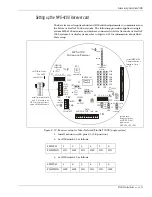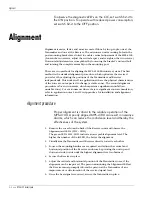
Troubleshooting
3 - 6 • • • MPS-4100 product guide
Troubleshooting
There are generally two problems, which can occur with microwave protection
systems, non-detection and a high false alarm rate.
Non-detection
There are several possible causes for an MPS-4100 Microwave system to be unable
to detect valid targets. The following procedure offers suggestions on how to
determine and correct these problems. This procedure assumes that the
microwave was properly aligned and calibrated before being put into service.
1. Remove the covers and pull out the tamper switch plungers at both the
Transmitter and Receiver to disable the tamper alarms.
2. Verify that power is present at both the Transmitter and Receiver. Measure the
voltage, at the inputs, to ensure that the voltage meets the m12
VDC requirement.
3. Verify that the frequency modulation selection jumpers on the Transmitter
and Receiver match.
4. Verify the tamper setting at both the Transmitter and Receiver and test the
tamper switch on each unit. Disable the tamper switch after verifying its
operation.
5. Occasionally, one of the microwave units can be accidentally knocked out of
alignment. Verify the alignment of the microwave system (refer to the
Alignment section). Realign the system as required.
6. Increase the sensitivity at RV1 to the maximum setting (turn fully clockwise)
and retest the microwave detection.
If the microwave does NOT detect a valid target, obtain an RMA number and
return the units to Senstar.
7. If the microwave detects valid targets at the maximum sensitivity setting,
reduce the sensitivity and retest the unit.
8. Continue reducing the sensitivity and retesting the zone until the detection
meets your site requirements.
High false alarm rate
If your microwave system is encountering an unacceptably high false alarm rate,
you must determine the cause of the false alarms and make adjustments as
required. Review the site planning information in Chapter 1 and Appendix a for
possible sources of false alarms. If possible causes are found, correct the
problems, (for example, tighten a loose fence panel adjacent to the microwave
zone, or fill a depression in which standing water accumulates).
1. Remove the cover from the receiver and pull out the tamper switch plunger
to disable the tamper alarm.
Содержание MPS-4100
Страница 1: ...Product MPS 4100 Microwave Protection System Guide E6DA0102 003 Rev C Third Edition April 27 2009 ...
Страница 6: ......
Страница 70: ......















































